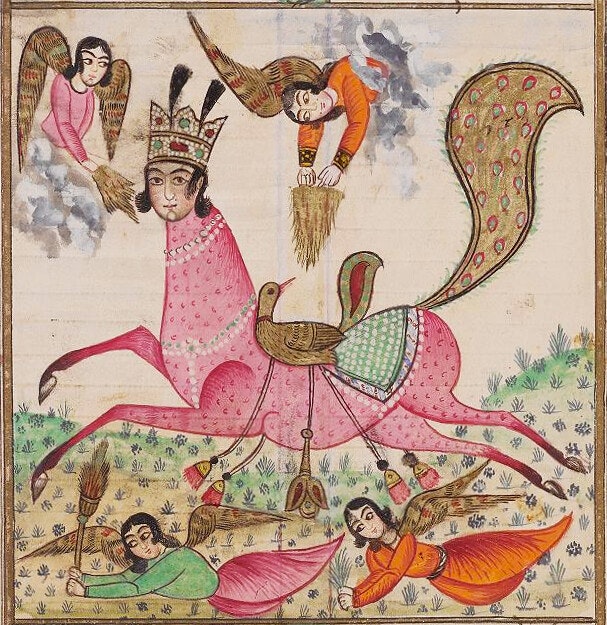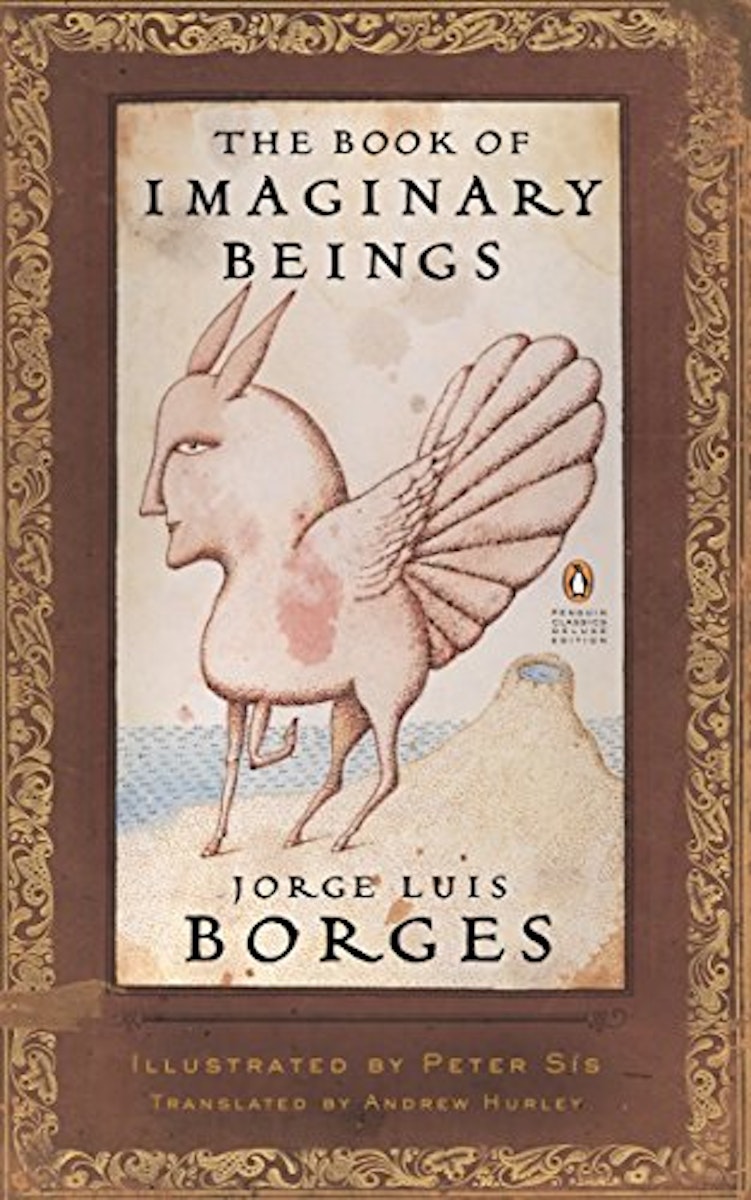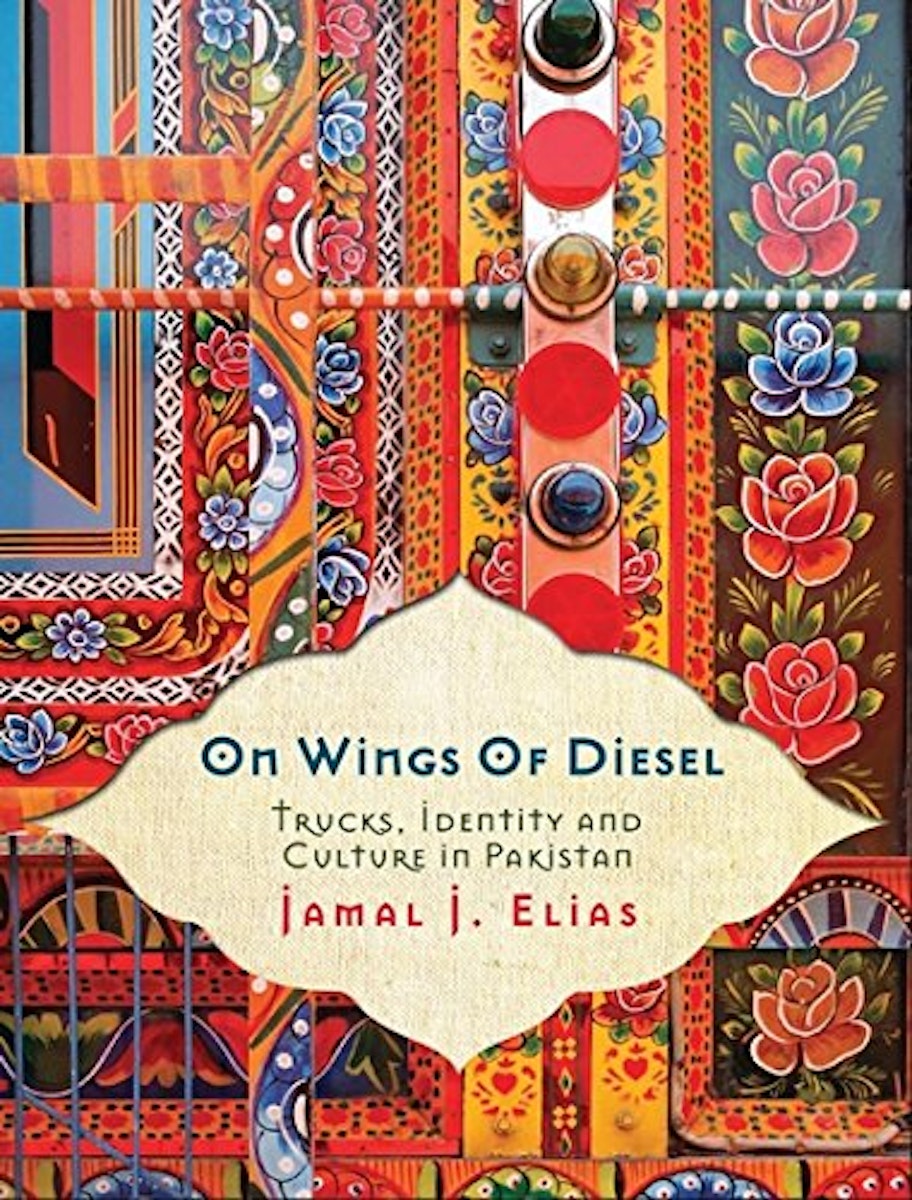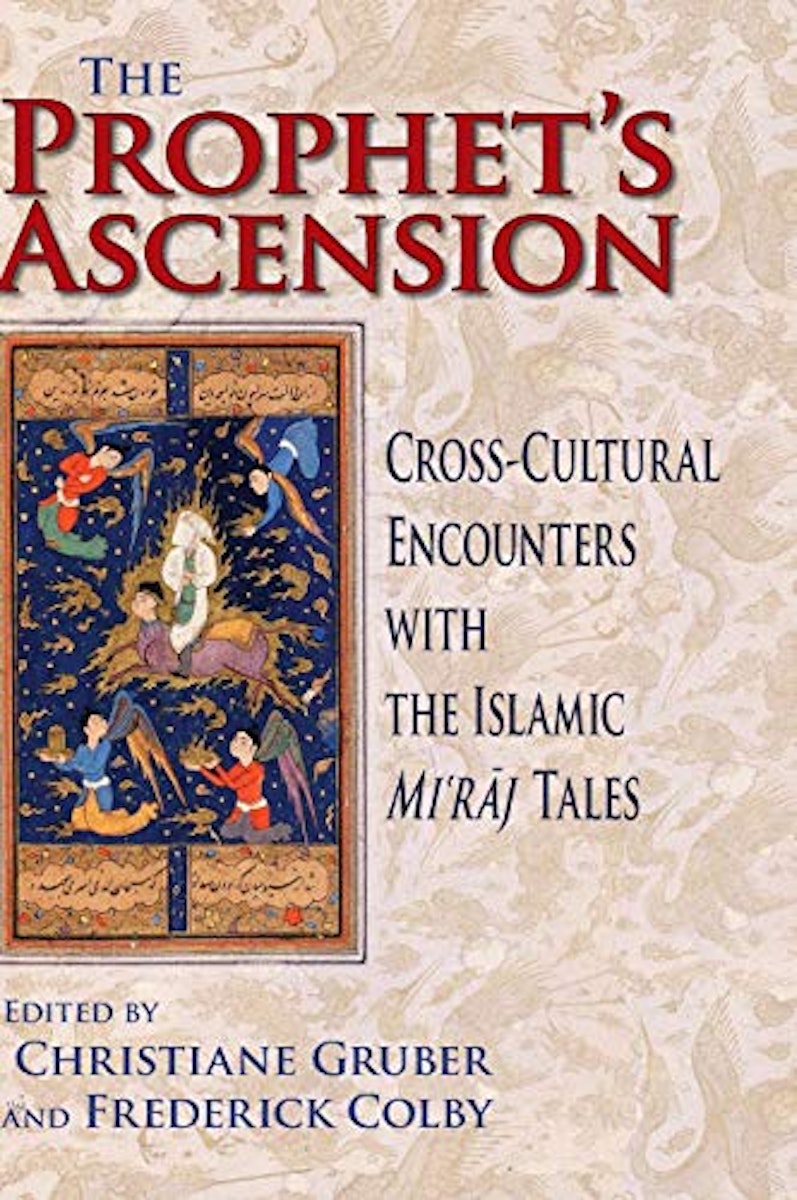
Out of Their Love They Made It A Visual History of Buraq
Although mentioned only briefly in the Qur'an, the story of the Prophet Muhammad's night journey to heaven astride a winged horse called Buraq has long caught the imagination of artists. Yasmine Seale charts the many representations of this enigmatic steed, from early Islamic scripture to contemporary Delhi, and explores what such a figure can tell us about the nature of belief.
September 21, 2016
 Scroll through the whole page to download all images before printing.
Scroll through the whole page to download all images before printing.Illustration of Buraq from Yusuf and Zulaykha, a 19th-century Judeo-Persian manuscript held at The Library of The Jewish Theological Seminary, MS 1534 — Source.
Oh this is the creature that never was.
They didn’t know it, still they dared
to love its stride, its bearing and its breast,
clean to the calm light of its eyes.
It was not. Out of their love they made it,
this pure creature . . .Rainer Maria Rilke,
from Sonnets to Orpheus
You came here because you were told to, and because here is where wonderful things are known to happen at night. You comb the streets, the tangle of unfamiliar smells — poultry, muskmelon, marigold — until you reach the pockmarked, once-red wall of the Ship Palace. There’s a sad sort of majesty to the place, but you’re not here for the beauty of ruins. You’re here for the hauz, the tank, its fabled waters now scummed over with algae and detritus. In your hand there is a pamphlet, saffron yellow and Hindi scrawl, with a telephone number and an instruction: to call between 6 and 8 p.m., to speak long and loud, to say hello.
You say hello and for a moment the horse flickers into life, its incandescent frame reflected in the water. A crowd has bloomed around the tank. Children sing into receivers: “hello” becomes a ten-syllable word. Soon the line is swamped as callers compete for the creature’s fitful attention. Not quite the miracle you had in mind, this rickety chimera — part neon piñata, part show pony, plus wings — assembled at the local metalworks and lit up by Chinese-made LEDs. Still, it is a thing of wonder: a winged horse rests on the surface of a lake and human voices make it glow.
 Scroll through the whole page to download all images before printing.
Scroll through the whole page to download all images before printing..
 Scroll through the whole page to download all images before printing.
Scroll through the whole page to download all images before printing.Screenshots from a film by Vishal Rawlley showing interaction with his installation Say Hello to the Hauz (2010) — Source.
Say Hello to the Hauz (2010), the brainchild of designer and filmmaker Vishal Rawlley, was an attempt to revive the long-neglected water reservoir in Mehrauli, one of the seven ancient cities that make up the state of Delhi. Drawing on the story of the Prophet Muhammad’s ascent to heaven astride a winged horse called Buraq, Rawlley designed a sculpture of the creature, fitted it with a phone line and a constellation of fairy lights, and left it to bob in the middle of the tank. People could dial in and speak; their voices would trigger the phantasmagoria. In the night footage preserved online, Buraq’s skeleton flashes on and off to the babble of unseen voices. The gasps are subtitled, the curiosity palpable. What to an outsider may have seemed an alien landing was really the portal to a mythic past: the horse had a history here.
The hauz was built in the thirteenth century after an early “slave sultan” of Delhi, Shamsuddin Iltutmish, dreamed he was visited by the Prophet Muhammad astride his winged steed. In the dream, the Prophet directed the king to a fountainhead that sprang where Buraq struck the ground with her hoof. On waking, the story goes, Iltutmish hurried to the site where he discovered the mark of a hoof imprinted on the earth. Dreams were an important part of the apparatus of medieval kingship; auspicious visions could steady a shaky crown. More, a widely circulated hadith declared that seeing the Prophet in a dream was equal to seeing him physically. To dream of the Prophet, then — in other words, to be considered a direct witness to his words and deeds, which together form the basis of Islamic law — was to be in a very privileged position indeed, and Iltutmish acknowledged the honour with due piety: he built a water tank, the Hauz-i-Shamsi, to mark the hallowed spot. For centuries the tank remained a site of local devotion. Magical properties were ascribed to its waters, and the great fourteenth-century traveller Ibn Battuta described how small boats ferried pilgrims to the red sandstone pavilion at its centre.
The story of the reservoir and its otherworldly aura echoes another origin myth: that of the Hippocrene, or Horse Fountain, which sprang from the hoof-scuff of Pegasus and is remembered in Greek mythology as a fount of poetic inspiration. Unlike Pegasus, however, who emerged fully formed from the blood of Medusa, Buraq’s conception was gradual, her evolution more peculiar and circuitous. She crops up on Persian miniatures and Pakistani trucks, Zanzibari ephemera and Libyan airplanes, Senegalese glass paintings and Indian matchboxes. Yet despite her many incarnations, or perhaps because of them, her essence remains elusive. There is no original, no definitive Buraq, but rather an unruly palimpsest of jumbled creeds, kitsch, and sheer artistic caprice.
 Scroll through the whole page to download all images before printing.
Scroll through the whole page to download all images before printing.Buraq with Taj Mahal, poster bought in Delhi. Sandria Freitag personal collection.
 Scroll through the whole page to download all images before printing.
Scroll through the whole page to download all images before printing.Leather shadow puppet with coloured pigments of a human-headed winged horse, most likely Buraq, from Istanbul, 1970s — Source.
 Scroll through the whole page to download all images before printing.
Scroll through the whole page to download all images before printing.The Buraq Worshipped by Two Princes, from Kashmir region, 19th century — Source.
The bare bones of Buraq look like this. From the Arabic root b-r-q, which means to shine or sparkle, her name evokes the lightning speed with which she carried the Prophet from Mecca to Jerusalem and thereon to heaven, an episode known as the mi‘raj, or “ascension”. The Qur’an alludes to this journey — in two cryptic verses that lend a whole chapter (“The Night Journey”) its title — but makes no mention of the vehicle. Because Buraq is absent from scripture, theologians give her short shrift, confining her to fly-by-night cameo roles: she first appears in the eighth century, in the earliest extant biography of the Prophet, as a “winged beast, white in colour, smaller than a mule and larger than an ass”. Buraq is a creature not of scripture but of lore, and in these early writings she is still a vague, unfinished thing, uncertain of shape, let alone sex. She will take centuries to evolve a human face: some five hundred years passed before the historian al-Tha‘labi wrote that Buraq “had a cheek like the cheek of a human being”, a not-quite metaphor that launched her never quite completed metamorphosis.
 Scroll through the whole page to download all images before printing.
Scroll through the whole page to download all images before printing.Detail from the 17th-century Persian manuscript Mi’rajnamah — Source.
 Scroll through the whole page to download all images before printing.
Scroll through the whole page to download all images before printing.The Fabulous Creature Buraq, from Deccan, India, ca. 1660–80 — Source.
The literature on Muhammad’s ascension to heaven grew to be enormous, but only after it slipped its scriptural moorings and slid out into poetry and folklore. Every life of the Prophet had a chapter on the subject, and scholars and mystics endlessly pondered its meaning. The story was deployed and reinterpreted among Islam’s subcultures, and also among its foes: there are versions in Malay, Uzbek, and Old French, in Buginese and Castilian, and a beautifully illuminated version in Chaghatay, a form of Middle Turkish named after Genghis Khan’s second son. Like Buraq herself, the story has never settled into a final form; it alters every time it is told. In some accounts, the duo do not stop at Jerusalem but venture through the seven heavens where, at the climax of their journey, the Prophet comes face to face with God. There he might meet a celestial rooster, or a polycephalous angel, and sometimes he pays a visit to his mother and father in hell. In others, the Prophet ascends to heaven by means of a glittering ladder, having fastened Buraq to a wall at the foot of the Temple Mount. (To this day the spot is known as the Buraq Wall to Muslims and the Western or Wailing Wall to Jews.)
Buraq was not born a woman, she became one — but when this happened is unclear. At some point an anonymous genius gave her a lustrous mane and a jeweled throat, and artists have never looked back. In her many guises classical and modern, Buraq is squarely female, adorned now with a peacock tail, now with a leopard-print coat, almost always with a gem-encrusted crown and brightly coloured wings. She grew into a staple of Muslim visual art, seizing the collective imagination until writers too followed suit. By the sixteenth century, the Persian historian Khwandamir could write that Buraq had
a face like that of a human and ears like those of an elephant; its mane was like the mane of a horse; its neck and tail like those of a camel; its breast like the breast of a mule; its feet like the feet of an ox. Its breast looked just like a ruby and its hair resembled white armor, shining brightly by reason of its exceeding purity.
The Persian language has no gender, obliging writers like Khwandamir to continue to describe Buraq in neuter terms even as she gained in feminine lustre and finery. It is perhaps no coincidence that Buraq is most spectacularly beautified in works by Persian miniaturists, as if these artists were giving excessively lavish expression to a femininity their language would not allow them to convey in words — as if the sexual restraint (the “greyness”) imposed by one medium made for an aesthetic of sexual maximalism in another.
 Scroll through the whole page to download all images before printing.
Scroll through the whole page to download all images before printing.Illustration from 1543 of the mi’raj probably created by the Persian court painter Sultan Muhammad, and used to illustrate the Khamseh by Nezami — Source.
 Scroll through the whole page to download all images before printing.
Scroll through the whole page to download all images before printing.Detail of Buraq from an illustrated manuscript, ca. 1525–35, from present-day Uzbekistan and Afghanistan, probably Bukhara and Herat — Source.
If Buraq’s early, skeletal form most recalled Pegasus, the sexless winged horse of classical antiquity, her new embellishments brought her closer to those other feminized hybrids, Sphinx and Chimera. Gustave Flaubert summed up the appeal of such composite, yet distinctly female creatures: “Who has not found the Chimera charming; who has not loved her lion’s snout, her rustling eagle’s wings, and her green-glinting rump?” In taking on the allure of these figures, however, Buraq also acquired a troubling ambiguity. After all, unlike those other mythical beings, Buraq is a devotional object, theologically more akin to an archangel than to a many-headed beast of prey. She is, existentially, inseparable from Muhammad — she exists only to carry him on his journey — making her feminized appearance all the more startling. Visually, they evolve in opposite directions: the more Buraq gains in baroque adornment, the more the figure of Muhammad seems to retreat into allegory. As her body comes to the fore, his grows austere and immaterial.
Bodies are everywhere in this story, and they are awkward. The friction between the historical Prophet and his fantastical mount, between the sacred and the physical, reflects a similar divide within Buraq herself: she has been perceived both as a dream-horse — mythical, sexless, emblematic — and as a creature of flesh. And Buraq as animal, especially in her more sexualised incarnations, in turn raises thorny questions about the body of the Prophet himself. Artists generally elided this problem, or creatively eluded it; early images of the Prophet tend to show him with a veil, and more recently his body has been symbolized by a white cloud, a rose or a flame.
 Scroll through the whole page to download all images before printing.
Scroll through the whole page to download all images before printing.Depiction of Buraq, with the Prophet Muhammad represented by stylised flames, from an 18th-century Ottoman manuscript, AD 1717 — Source.
Did the Prophet ascend to heaven in body or only in spirit? For all those who grappled with the meaning of the night journey, this was a central question. One solution was to skirt the problem of bodies altogether. The Persian polymath Avicenna thought the mi‘raj a purely internal, intellectual journey; less concerned with Muhammad’s ascent than with the potential elevation of anyone engaged in abstract thought, he used the story’s currency as a folk narrative to coax a largely uninitiated community into the pursuit of philosophy. For Avicenna, the ascension tale was a useful means of dispelling anxieties about foreign intellectual traditions: by presenting these questions in terms familiar to his Muslim audience — and by reframing the Prophet’s ascension as a spiritual journey one should try to emulate — he showed that the study of philosophy was not only compatible with traditional Islamic teachings, but central to the task of the pious believer.
This sounds all very well and rational, but if bodies are erased from the story — if the night journey was merely a voyage of the mind, a static reverie — what is to be done with Buraq, who is pure colour and pure form, who stands for nothing beyond her exuberant self? Avicenna doesn’t say. The reality of the prophet’s flight is dismissed in a line (“It is known that he did not go in the body, because the body cannot traverse a long distance in one moment”), but winged horses are not so easily idealised. Buraq is unavoidably, infectiously physical. Astride her back, the Prophet is wrenched out of abstraction, trapped and tangled up in the body of the beast as Leda by the swan in Yeats’ poem: “and how can body, laid in that white rush / But feel the strange heart beating where it lies?”
 Scroll through the whole page to download all images before printing.
Scroll through the whole page to download all images before printing.Page from 16th-century Ottoman ruler Murad III’s commissioned copy of Siyer-i Nebi, the Turkish epic about the life of the Prophet – Source.
Others felt it too. The Ottoman poet Veysi was obsessed with the physical character of the night journey, which he held to be the salient event in Muhammad’s biography; his contribution to the genre was accordingly titled The Life of the One Who Ascended. Veysi’s most famous work, the Habname or Book of Dreams, takes the form of a dream conversation between Sultan Ahmed I and Alexander the Great, and suggests a belief in the essential fluidity between the world of dreams and real life. A similar fluidity pervades Veysi’s account of the night journey, which stresses the physical reality of the ascension and of the transcendental world to which the Prophet traveled. Central to his argument are detailed descriptions of Buraq and of the Lote Tree of the Limit, which marks the edge of heaven and the boundary beyond which nothing can pass. The tree has an infinite number of branches, each with an infinite number of leaves, and on each leaf sits a huge angel carrying a staff of light. A Sufi text calls it “a tree without description”, which grew from “an unimaginable ocean of musk”. What sorts of things are these that are rendered in exquisite detail yet remain “without description”, both sensually evoked and still “unimaginable”? The clue to Buraq’s nature, perhaps, lies in this paradox.
That Avicenna and Veysi represent seemingly irreconcilable views — that Buraq can be considered both pure abstraction and pure physicality — is hardly surprising; it is in her nature to divide. In its earliest versions the ascension story functioned as a kind of shibboleth: those who believed in Muhammad’s heavenly ascension were regarded as having accepted his prophetic mission, whereas those who did not were deemed to have rejected Islam itself. This problem of belief was recently revived in a debate archived on YouTube under the title “Richard Dawkins versus Muhammad’s Buraq horse”. The Oxford Union had invited Dawkins, the evolutionary biologist, to share the stage with the journalist Mehdi Hasan — Science v. Religion, firebrand against firebrand. At one point in the video, Dawkins exclaims twice in disbelief: “You believe Muhammad flew to heaven on a winged horse!” The crowd jeers, Hasan flounders, and the debate grinds to a deadlock. The mere mention of Buraq — her quaintness, her garish absurdity — was apparently enough to clinch the argument, exposing Hasan the “believer” as irretrievably backward, painfully naive, or a fraud.
The debate made for uncomfortable viewing. It seemed odd that among all the mystery of religious lore, the night journey — and its sensational metonym, the winged horse — should be singled out for special treatment in this way. Buraq, true to her name, seems to have become a lightning rod in the atheist crusade, a byword for the irrationality of Islam and religion in general. Yet by posing the question restrictively in terms of “belief”, both speakers ignored the many ways in which believers and non-believers might engage with an object like Buraq (in the literal sense of object, “a thing presented to the mind”), not simply as an article of faith but as metaphor, myth, paradox, emblem, or visual trope.
 Scroll through the whole page to download all images before printing.
Scroll through the whole page to download all images before printing.Maometto portato in cielo [Muhammad taken to heaven], Italian engraving by Migliavacca, ca. 1823–38 — Source.
Buraq is a product of miscegenation. First found in the nineteenth century BC, the motif of winged horses was picked up by the Assyrians, made its way through Greece and Asia Minor, and eventually became ubiquitous in Eurasia: Etruscans, Persians, Celts, Finns, Koreans, Bengalis, and Tatars all boast some version of the myth. Often these horses are able to travel at supernatural speed; they sometimes have a human head; and they can also be linked to storms and lightning. So it turns out that Buraq, far from being the risible cultural aberration deplored by Dawkins, is actually a version of one of the oldest and most widespread myths in our history, her shimmering body a receptacle for the many myths, metaphors, and moral concerns that Islam inherited.
The world was a combination of real and mythological objects until somewhat recently; a clear distinction could hardly be made before the onset of modern comparative biology. And yet science has not abolished the interstitial zone which a figure like Buraq inhabits: we need such liminal objects to connect seemingly divergent realms of empirical and spiritual experience. Her presence in contemporary culture acts as a bridge between knowledge and belief, between rationalist taxonomies of the world and the vestigial power of myth. This idea finds its most forceful and literal expression in the Islamic transport industry, where the figure of Buraq, usefully combining piety and speed, recurs as a kind of patron saint. She gives her name to airlines from Libya to Indonesia, to bus companies, freight ships and motorcycle-taxis, to a space camp, to an engineering college, and to Pakistan’s first drone. The fluidity of Buraq as an aesthetic and linguistic object perhaps explain her pliability in being put to commercial use: she presides not just over wings and wheels but is also used to sell plastic and PVC, heavy metal and heavy-duty diesel (BURAQ LUBRICANTS), Indian food, and surgical instruments.
The longer you study her, the deeper you dig, the more elusive Buraq’s identity becomes. In a luminous essay, “The Chimera Herself”, Ginevra Bompiani parses the symbolic implications of these composite creatures. The many-headed Chimera exemplifies the arbitrary union of countless experiences — she is the synthesis of disparate things. “She who, in myths, was purely a fiery apparition, without a voice or a history, was to become, in the early days of modern philosophy, the ens rationis, the creature of language, the metaphor of metaphor”. As a hybrid, Buraq does what metaphors do: she makes the impossible visible. “Achilles is a lion” is literally false; you cannot figure it, yet there it is on the page. In the basic metaphorical statement, “A is B”, Buraq plays the same role as the copula (the “is”), brazenly flouting the law of non-contradiction, mixing that which should not be mixed. “Since she does not exist”, Bompiani writes, “the question arises as to what Chimera is”. That depends, some might say, on what the meaning of the word is is.
Yasmine Seale is a writer and translator. She is reading for a PhD on Ottoman attitudes to antiquity at St John's College, Oxford.










